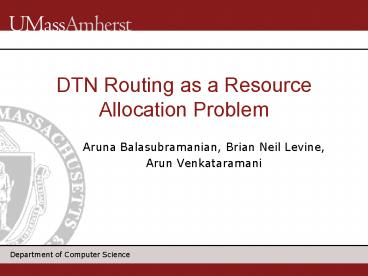Aruna Balasubramanian, Brian Neil Levine, - PowerPoint PPT Presentation
1 / 27
Title:
Aruna Balasubramanian, Brian Neil Levine,
Description:
Minimize average delay. Maximize packets meeting their ... Example 3: Minimize maximum delay. U(i) = negative expected delay of i if i has highest delay; ... – PowerPoint PPT presentation
Number of Views:79
Avg rating:3.0/5.0
Title: Aruna Balasubramanian, Brian Neil Levine,
1
DTN Routing as a Resource Allocation Problem
- Aruna Balasubramanian, Brian Neil Levine,
- Arun Venkataramani
2
What are DTNs?
- Delay/Disruption Tolerant Networks
- end-to-end path may never exist
- routing must use pair-wise transfers staggered
over time
3
Why useful?
- Infrastructure expensive or nonexistent
- e.g., Daknet, Kiosknet, OLPC
- Infrastructure cannot be deployed
- e.g., underwater, forests, outer space(!)
- Infrastructure limited in reach
- e.g., Dieselnet, Cartel, Drive-thru-internet,
VanLan
DTNs high delay, low cost, useful bandwidth
4
Why challenging?
- Wired/Mesh/MANETs
- Known topology
- Low feedback delay
- Retries possible
- DTNs
- Uncertain topology
- Feedback delayed/nonexistent
Primary challenge finding a path to the
destination under extreme uncertainty
5
Existing routing mechanisms Incidental
- DTN routing mechanisms
- Estimating meeting probability
- Packet replication
- Coding
- Waypoint stores
- Prior knowledge
- Metrics desired in practice
- Minimize average delay
- Maximize packets meeting their deadlines
- Incidental Routing
- Effect of mechanism on routing metric unclear
Goal Design Intentional DTN Routing Protocol,
RAPID
6
Roadmap
- Background and Motivation
- RAPID
- Replication to handle uncertainty
- Utility-driven resource allocation
- Distributed algorithm
- Deployment and Evaluation
7
Replication to handle uncertainty
- Replication can address
- Topology uncertainty
- High delay feedback
- Naïve replication strategy Flooding
- Risks degrade performance when resources limited
How to replicate when bandwidth is limited?
8
Routing as a resource allocation problem
- Problem
- Which packets to replicate given limited
bandwidth to optimize a specified metric - RAPID Resource Allocation Protocol For
Intentional DTN Routing
9
RAPID utility-driven approach
RAPID Protocol (X,Y) 1. Control channel
Exchange metadata 2. Direct Delivery Deliver
packets destined to each other 3. Replication
Replicate in decreasing order of marginal
utility 4. Termination Until all packets
replicated or nodes out of range
Change in utility
Packet size
10
Translating metrics to utilities
- Utility U(i) expected contribution of packet i
to routing metric - Example 1 Minimize average delay
- U(i) negative expected delay of i
- Example 2 Maximize packets delivered within
deadline - U(i) probability of delivering i within
deadline - Example 3 Minimize maximum delay
- U(i) negative expected delay of i if i has
highest delay - 0 otherwise
11
Utility computation example
- U(i) -(T D)
- T time since created, D expected remaining
time to deliver - Simple scenario
- uniform exponential meeting with mean
- global view
12
Utility computation example
Deadline of i lt T Deadline of j T1 gt T
Metric Min average delay
Metric Max packets delivered within deadline
Replicate j
Replicate i
13
RAPID metrics
- Metrics (i) min avg delay, (ii) min max delay,
(iii) max packets delivered by deadline - RAPID replicates packets that locally improve
routing metric most - For all three metrics, utility is function of
delivery delay
14
Roadmap
- Background and Motivation
- RAPID
- Replication to handle uncertainty
- Translating metrics to utilities
- Distributed algorithm
- Deployment and Evaluation
15
Distributed algorithm challenges
Meeting times unknown
1sec
5sec
2sec
b
a
a
c
b
b
d
16
Distributed algorithm challenges
Meeting times unknown
3pkt/sec
2pkt/5sec
Transfer size unknown
1pkt/2sec
Replica locations unknown (delivery unknown)
b
a
a
c
b
b
d
Distributed control channel to build local view
of unknowns
17
Distributed control channel
per node
Expected inter-meeting time
3pkt/sec
2pkt/5sec
Expected transfer size
1pkt/2sec
per packet
Known replica locations
Expected local delay
b
a
a
DX,b 4sec
c
b
b
Expected delay of packet b min(DW,b, DX,b, DY,b)
d
5
4
1
18
RAPID recap
RAPID Protocol (X,Y) 1. Control channel
Exchange metadata 2. Direct Delivery Deliver
packets destined to each other 3. Replication
Replicate in decreasing order of marginal utility
4. Termination Until all packets replicated or
nodes out of range
19
Is RAPID optimal ?
- RAPID No knowledge
- Complete knowledge
- NP Hard
- Approximability lower bound vn
- Partial knowledge
- Average delay arbitrarily far from optimal
- Delivery rate O(n)-competitive
- DTN unknowns
- Meeting schedule
- Packet workload
- Global view
Empirically, RAPID is within 10 of optimal for
low load
20
Roadmap
- Background and Motivation
- RAPID
- Replication to handle uncertainty
- Translating metrics to utilities
- Distributed algorithm
- Deployment and Evaluation
21
Deployment on DieselNet
22
Results from deployment
- Synthetic workload
- Deployed from Feb 6, 2007 until May, 14, 2007
23
Results from deployment
- Per day stats
24
Validating the simulator
- Trace-driven simulator
- Simulation results within 1 of deployment
25
Results Mobility from DieselNet traces
26
Results Known mobility model
27
Conclusions
- Intentional DTN routing feasible despite high
uncertainty - tunable to optimize a specific routing metric
- Simple utility-driven heuristic algorithm
performs well in practice - DTN routing problem fundamentally hard
- Ongoing work
- Application development on DTNs
- Graceful degradation across mesh networks and
DTNs
traces.cs.umass.edu
28
- Questions?































